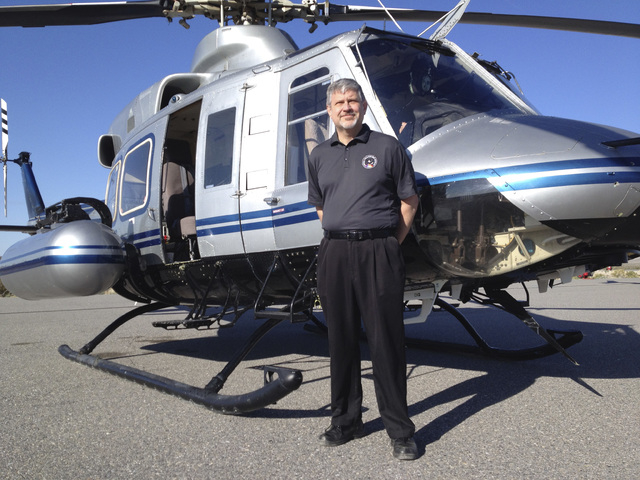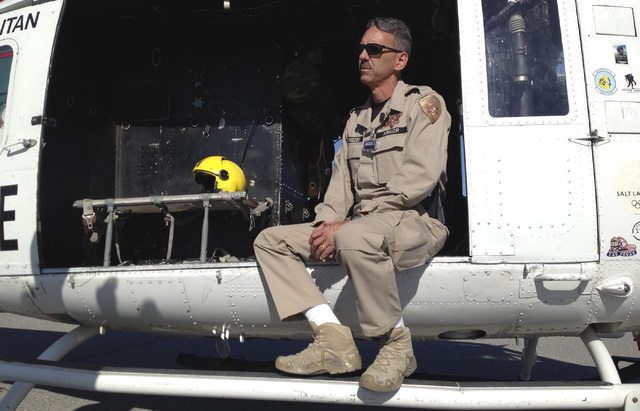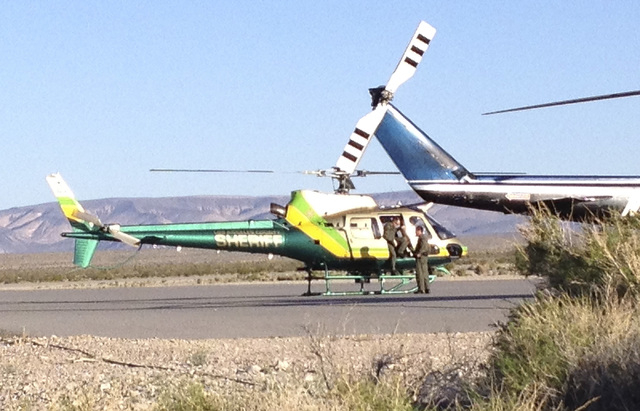Nevada nuclear drill prepares local, federal agencies for unthinkable
The sound of helicopters flying toward the Nevada National Security Site broke the early morning silence Tuesday at Desert Rock Airport, 65 miles northwest of Las Vegas.
The thunder from the six aircraft is what tourists and residents might expect should authorities ever call for a response to a suspected nuclear device in the Las Vegas Valley.
It was 7 a.m., time for the biggest drill yet for federal agencies and police from Las Vegas and Los Angeles. They will spend the next couple of days training for the unthinkable — a so-called “dirty” nuclear bomb that’s hidden or deadly radioactive remnants from a power reactor gone haywire, such as what happened in Japan in 2011.
“This is really the first time we’ve had a chance to get federal and local agencies together to do a major exercise like this, measuring radiation using the aircraft and the capabilities that we have,” said Alan Remick, aerial measuring system program manager for the National Nuclear Security Administration, a branch of the Department of Energy.
The goal of the field portion of the exercise, dubbed Wings, is to integrate the various agencies into a single response and coordinate efficient use of the aircraft. Each is equipped with instruments that can detect dangerous nuclear sources apart from background levels of radiation. In this case, four helicopters and two twin-engine airplanes with sensitive gear either outside in pods or inside the cabins pick up signals to measure varying strengths of gamma rays from the ground.
Helicopters can do this while flying between 150 feet and 600 feet above the surface, while longer-range, fixed-wing planes gather a big-picture view from 1,000 feet.
“We’ve never really done it with so many agencies before. We’ve never incorporated the data from different systems into one plot,” Remick said.
The exercise is a hedge against terrorists threatening homeland security in the post-9/11 world, and to practice responding to a major nuclear accident such as the Fukushima meltdown when nuclear power reactors lost coolant after an earthquake.
“We flew in Japan for about 500 hours. We saw that was a major need for monitoring,” Remick said about the team of 30 scientists, technicians and pilots who were sent by the U.S. government to survey the 2011 nuclear disaster.
“We do this in case there’s an event in the United States: a nuclear power plant emergency, a radiologic dispersant device, or an improvised nuclear device in an American city.”
The products of the exercise “are really for our own use and training,” he said. “This will inform our planning for future events and future responses.”
Tuesday’s exercise involved a few dozen support staff crew members for an Army Blackhawk helicopter, a fixed-wing, twin-engine aircraft from U.S. Customs and Border Patrol, a twin-engine Beechcraft airplane from the NNSA’s Remote Sensing Laboratory, an NNSA Bell helicopter and helicopters from the Metropolitan Police Department and the Los Angeles County Sheriff’s Department.
Harvey Clark, a nuclear physicist for National Securities Technologies, the security site’s contractor and senior fellow at the Remote Sensing Laboratory at Nellis Air Force Base, said the radiation detectors are “a lot like light meters.”
Similar to how a printer makes a picture by plotting pixels across a page, the back-and-forth positioning of detectors mark a radiation point every second. Scientists can then plot the most prolific signals where a radioactive source is located.
“Some instruments detect the amount of exposure rate,” Clark said. “Others measure the signature, or spectrum. They can measure each color” and determine the type of radioactive source.
Las Vegas police detective Rick Breeden said helicopter flights to detect neutrons and gamma rays from radioactive materials that could harm the public are done multiple times a year in the valley, usually before big events such as New Year’s Eve and NASCAR races.
Heightened aerial surveillance began in the aftermath of 9/11. While authorities have been on the lookout for dirty bombs, they have never found one.
“We fear that type of attack on the Strip, and that’s why we fly preventive missions,” said Breeden, who is part of a criminal hazardous materials team that investigates potential threats from dirty bombs, anthrax and ricin, among other dangerous materials.
Contact reporter Keith Rogers at krogers@reviewjournal.com or 702-383-0308. Follow him on Twitter @KeithRogers2.
























